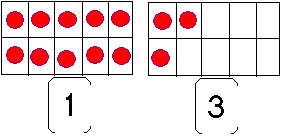Or search by topic
Number and algebra
Geometry and measure
Probability and statistics
Working mathematically
Advanced mathematics
For younger learners
Published 2011 Revised 2014
Number Sense Series: A Sense of 'ten' and Place Value
You can read an updated version of this article in our Number Sense and Place Value Feature.
Once a basic number sense has developed for numbers up to ten (see Developing Early Number Sense) a strong 'sense of ten' needs to be developed as a foundation for both place value and mental calculations. (This is not to say that young children do not have an awareness of much larger numbers. Indeed, there is no
reason why children should not explore larger numbers while working in depth on 'tenness').
Ten-Frames
Ten-Frames are two-by-five rectangular frames into which counters are placed to illustrate numbers less than or equal to ten, and are therefore very useful devices for developing number sense within the context of ten. The use of ten-frames was developed by researchers such as Van de Walle (1988) and Bobis (1988). Various arrangements of counters on the ten frames can be used to prompt
different mental images of numbers and different mental strategies for manipulating these numbers, all in association with the numbers' relationship to ten.
For example, examine the three ten-frames below. What numbers are illustrated? What does the particular arrangement of the counters prompt you to think about the numbers? What can you say about each number's relationship to ten?


This child had a strong sense of ten and its subgroups and was assisted by the frame of reference provided by the ten-frame. Once this type of thinking is established, the ten-frame is no longer needed. Although dealing with whole numbers initially, the 'part-part-whole' thinking about numbers supports the understanding of fractions, in particular tenths.
Place Value
'Ten' is of course the building block of our Base 10 numeration system. Young children can usually 'read' two-digit numbers long before they understand the effect the placement of each digit has on its numerical value. For example, a 5 year-old might be able to correctly read 62 as sixty-two and 26 as twenty-six, and even know which number is larger, without understanding why the numbers are
of differing values.
Ten-frames can provide a first step into understanding two-digit numbers simply by the introduction of a second frame. Placing the second frame to the right of the first frame, and later introducing numeral cards, will further assist the development of place-value understanding.

Games
Ten-Frame Flash (5-7 years) 4 players
Twenty (5-7 years) 3-4 players
- Each turn could include placing the correct numeral cards under the frames.
- Each player can also announce the number of counters needed to reach twenty. The exact number must be rolled to win the game.
Guess What (6-8 years) 2 players
References
Van de Walle, J. (1988). The early development of number relations. Arithmetic Teacher. Vol.35, February, 15-21.
Bobis, J. (1996). Visualisation and the development of number sense with kindergarten children. In Mulligan, J. & Mitchelmore, M. (Eds.) Children's Number Learning: A Research Monograph of the Mathematics Education Group of Australasia and the Australian Association of Mathematics Teachers. Adelaide: AAMT
Note: An article, called Subitizing: What is it? Why Teach it? (by Douglas Clements) in the March 1999 issue of Teaching Children Mathematics covers similar material to this month's and last month's article. The journal is published by the National Council of Teachers of Mathematics (USA) and can ordered via their website www.nctm.org

